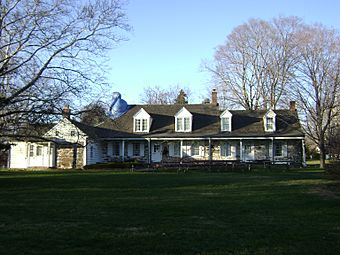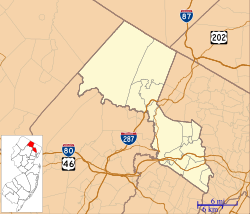Van Riper–Hopper House facts for kids
|
Van Riper–Hopper House
|
|

Van Riper–Hopper House Museum, seen from the front in mid-December, 2011.
|
|
| Nearest city | 533 Berdan Avenue, Wayne, New Jersey |
|---|---|
| Area | 2.7 acres (1.1 ha) |
| Architect | Van Riper, Uriah R. & Berdan |
| Architectural style | Dutch Colonial |
| NRHP reference No. | 72000806 |
Quick facts for kids Significant dates |
|
| Added to NRHP | August 21, 1972 |
The Van Riper–Hopper House is a historic building in Wayne, New Jersey. It was built in 1786 and is now a museum. This special house was added to the National Register of Historic Places on August 21, 1972. It helps us learn about the past in Wayne Township.
Contents
History of the House
Building a Family Home
The Van Riper–Hopper House was built in 1786. A man named Uriah Van Riper built it for his family. The house stayed in the Van Riper family for many years. Later, Uriah's great-granddaughter, Mary Ann Van Riper, inherited the house. She married Andrew Hopper in 1872. This is why the house has both "Van Riper" and "Hopper" in its name!
From Home to Museum
Before Uriah built the house, his father, Richard (Dirck) Van Riper, bought the land in 1762. The property was quite large, about 145 acres. At that time, the area was known as Saddle River. Richard Van Riper mentioned Saddle River in his will. On July 6, 1964, the house officially opened as the Wayne Township Museum. A "barn house" that was once near the Wayne Hills Mall was moved to the museum property.
Where the House Is Located
Changes in Location Names
When the land for the Van Riper–Hopper House was first bought, Northern New Jersey was divided into two parts: East and West Jersey. Today's Wayne Township was known as Saddle River back then. It was part of Bergen County. Now, this area is known as Passaic County.
How the House Was Built
Dutch Colonial Style
The Van Riper–Hopper House was built in the traditional Dutch Colonial style. This style was common in New Jersey long ago. It often features a wide, sloping roof. In the 1950s, a past owner made some changes to the second floor. They added built-in closets and dressers. These features were not typical of the original Dutch Colonial style.
See Also




